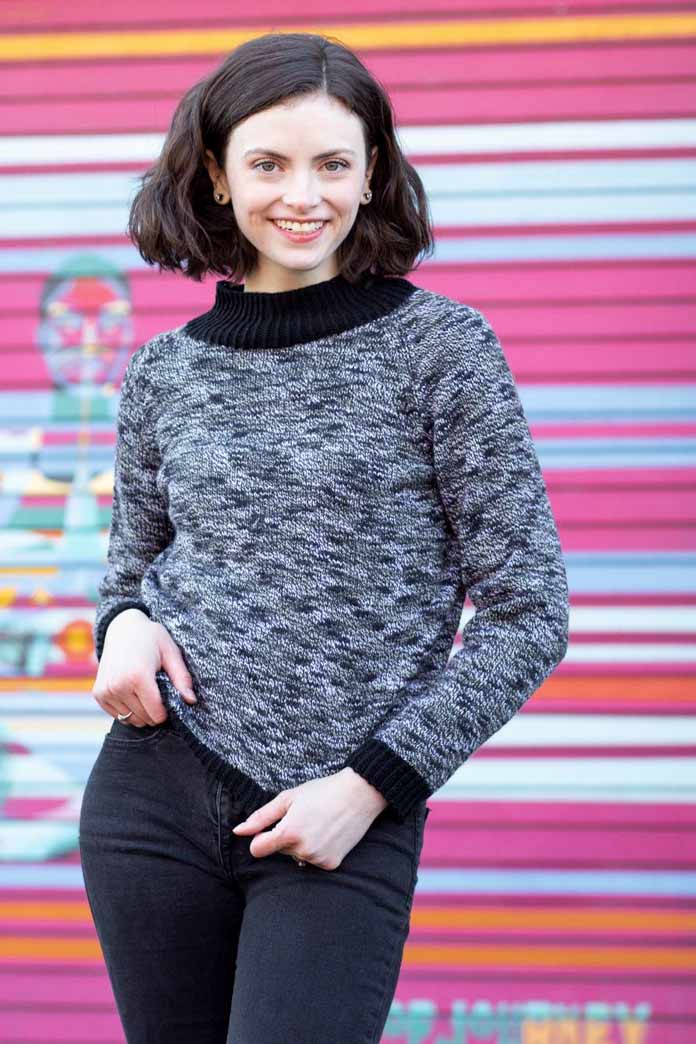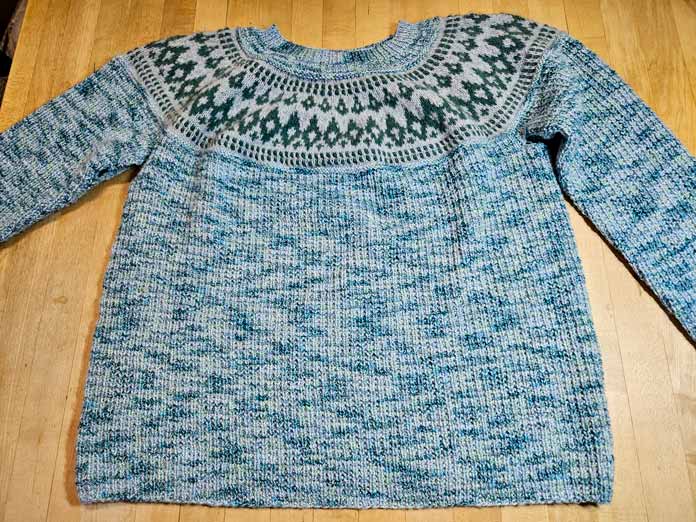This week I’m working with FIBRA NATURA Cobblestone yarn which is a soft, 2-ply 100% merino wool yarn. One ply is variegated, featuring a variety of beautiful colours, and the second ply is a solid color.
Yesterday I made the Cloverdale Cowl which is a textured pattern stitch that embraces the random color pooling of the yarn.
Today, we’re talking about knitting sweaters and tips on downplaying the effect of unwanted color pooling.

Gravel Sweater designed by Rachel Brockman for Cobblestone
Gravel is a free sweater pattern designed by Rachel Brockman for Cobblestone yarn to be knitted along with a solid color in Universal Yarn Donnina. The solid color tends to draw your eye, however the pooling effect of the yarn is still very visible. The color depicted is Tuxedo, which we all associate with the high contrast of black and white. It’s also important to note that the sweater shown is a size small. Depending on the size you’re making, the color pooling could be very different.
So how can you know what to expect? A 4”x 4” swatch will only tell you the gauge and needle size, not the color pooling. The sweater is knit in the round from the bottom up, then separated at the underarms and worked flat. The sleeves are worked flat and seamed. What does all that mean? You have a different stitch count for each of the sections therefore, the pooling will vary between the bottom and top of the sweater and on the arms.
You may be wondering why I’m so concerned about the pooling on a sweater. Let me share a story with you about a variegated cotton sweater I made for spring several years ago. The variegated yarn was comprised of soft shades of blues, mauves, and white. The sweater was a boat neck worked flat and seamed with ¾ sleeves. There was some color pooling but I thought it looked okay until I tried it on. A big pool of mauve attracted the eye directly to the left girl. Not a good look for me, or for most women I dare say. Since the front and back of the sweater were identical, I thought that I’d just turn it around. Now the attention was drawn to the right girl with a big pool of white. All my hard work and the freshly finished sweater was now relegated as yard work clothing as I had no intention of ever wearing it in public. Since then, I carefully plan my project before using a variegated yarn.
But, do not be discouraged by that story. Since then, I’ve learned a few tips about using variegated yarn on sweaters that I’ll share with you. If you recall from Tuesday’s post, Knitting a swatch with various needle sizes tells a colorful story, I mentioned if the pattern is more textured or free-form, the pooling can add to the attractiveness of the finished product and/or not be as conspicuous. Here’s an example.

Yoked sweater knit with Cobblestone in color Meadow
I love the look of this sweater. The textured stitch pattern tends to soften the pooling effect of the yarn and the contrasting yoke in a light grey and dark green draws the eye. This sweater was designed and knit by my friend Linda using Cobblestone in color Meadow.
The stitch pattern used is a broken rib, or also known as a garter rib and it’s very easy to do.
Knit 1 round (or row,) then K1, P1 for one round (or row).
It gives a lovely texture to the sweater and can be incorporated into any sweater pattern. Now picture the Gravel sweater using this stitch pattern instead of stocking stitch. Any variation in the stitch count and method (round vs. flat) would downplay the variation in pooling; same sweater pattern but softening the unforeseen pooling with texture. You’d end up with a lovely marled look without a lot of planning or a toss of the dice.
Would this tip have saved my spring sweater? Absolutely not. The big difference between the variegated yarn I used on my sweater and Cobblestone is the length of each color run. The yarn I used had fairly long color runs whereas Cobblestone is short. The pooling blobs on my sweater were large as in a cup size A blob atop a cup size C person; bullseye! TMI, but you get the point (no pun intended). As you noticed in my swatches in my second post this week, the Cobblestone blobs can vary from a zigzag striping effect to a marled look. In other words, a toss of the dice.
Tomorrow I’ll explore more about the incorporation of a strong color in combination with Cobblestone. I think you’ll be surprised by the beautiful effect this can have on your finished project.
I hope you’ll join me as I show an example of tossing the dice while adding a color distraction with FIBRA NATURA Cobblestone yarn.
This is part 4 of 5 in this series
Go back to part 3: A knitting project that embraces the color pooling
Go to part 5: Incorporating a high contrast color yarn with UY Cobblestone
